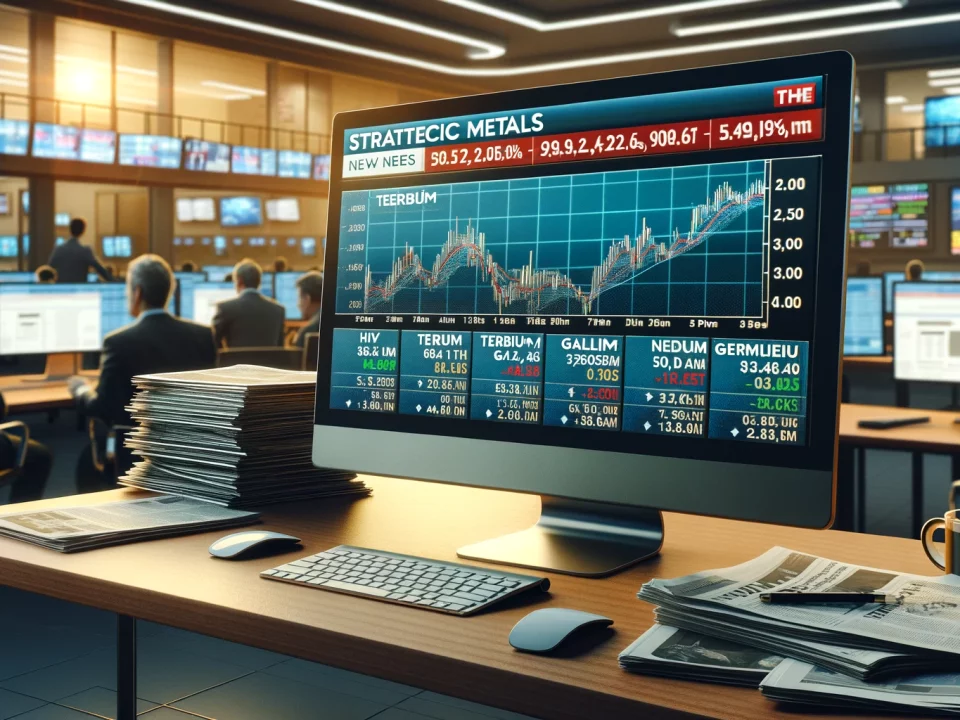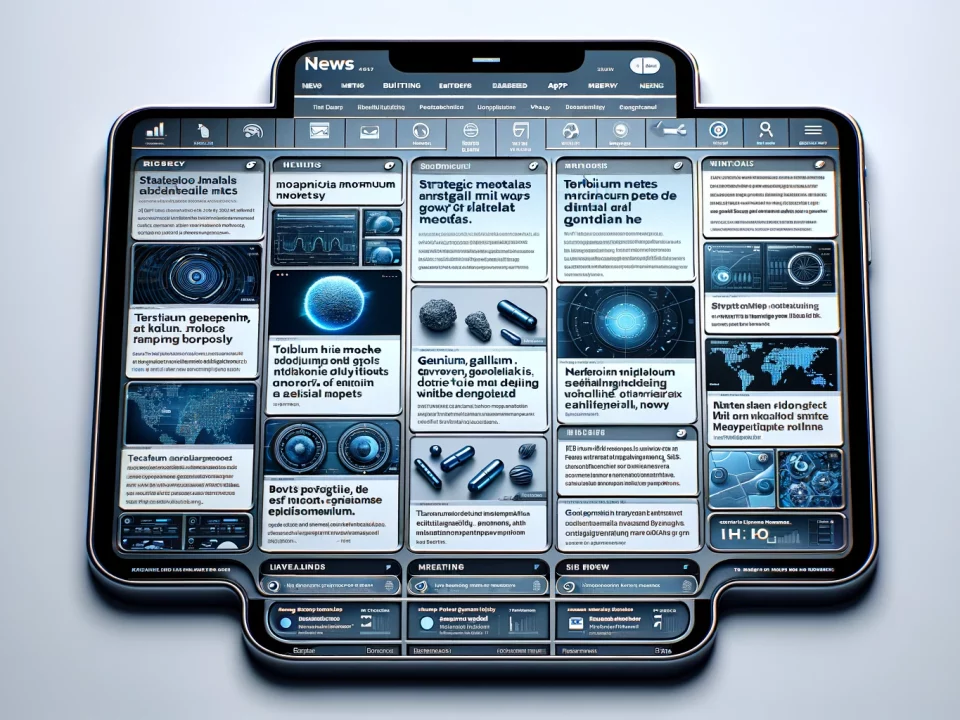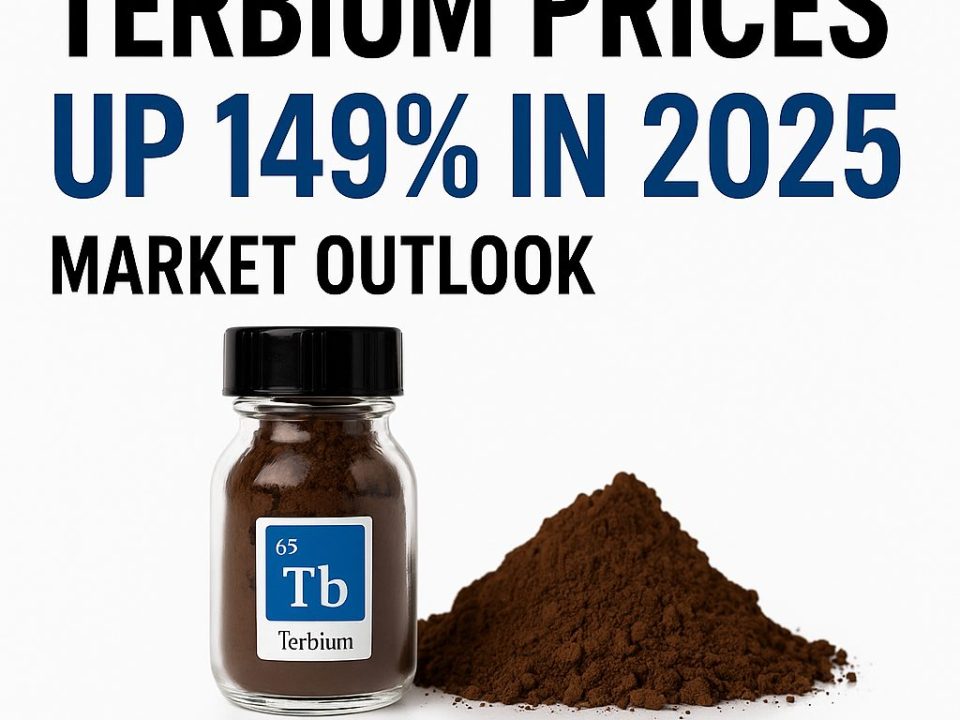
Weekly News Review September 15 – September 21 2025
September 21, 2025
Praseodymium Outlook 2026–2030: Demand Rising, Supply Tight
September 30, 2025China released detailed export figures for August this week. The most striking development was in the rare earth element dysprosium, whose exports rose to their highest monthly level since February. Meanwhile, the United States announced plans to expand its national stockpile of critical minerals and add scandium to it.
All this and more from our media portal rawmaterials.net,
GALLIUM EXPORTS DECLINE IN AUGUST, WHILE GERMANIUM REMAINS SUBDUED:
China exported more germanium in August, according to the latest data from customs authorities. Compared with the previous month, volumes rose by more than 50 percent to 1,166 kilograms, though exports remain well below last year’s levels. The main destinations for the technology metal were Russia and Germany.
In contrast, gallium exports fell in August. Outbound shipments totaled 7,201 kilograms, down more than 20 percent from July.
Both gallium and germanium are critical raw materials for high-tech applications, particularly in semiconductor manufacturing, fiber-optic production, and optical technologies such as infrared systems. Since the summer of 2023, China has required export licenses for these metals. In December 2024, Beijing imposed an explicit export ban on both materials and several other critical resources, including those destined for the United States.
This move continues to have a lasting impact on global supply chains.
DYSPROSIUM EXPORTS SURGE IN AUGUST, TERBIUM DECLINES:
The latest export data from Chinese customs reveal a sharp rebound in dysprosium shipments, while terbium exports edged lower compared to July. A total of 16,686 kilograms of dysprosium cleared customs in August, the highest monthly volume since February. Nearly all of it was destined for South Korea, with smaller amounts going to Japan and Norway.
Terbium flows tell a similar story. While exports slipped to 5,500 kilograms, down from 7,000 kilograms in July, only three countries received material. With 4,000 kilograms, the majority went to Japan, followed by South Korea with 1,000 kilograms and Estonia with 500 kilograms.
Both dysprosium and Terbium have been subject to China’s export licensing system since April, requiring official approval before shipments can proceed. The restrictions initially caused exports to collapse to nearly zero, followed by a gradual recovery. Dysprosium and Terbium are critical for high-tech industries, especially in the production of advanced permanent magnets, where they enhance heat resistance and overall performance.
CHINESE RARE EARTH MAGNET EXPORTS PICK UP AGAIN:
China increased exports of rare earth magnets again in August. Compared with July, shipments rose by more than ten percent to 6,146 tonnes, according to the latest data from Chinese authorities. The largest recipient was Germany, which imports these components for wind turbines as well as electric motors used in cars and mobile devices. The United States followed, receiving less than half the volume shipped to Germany, while significant shipments also went to Vietnam, South Korea, and Mexico.
In May, shipments had temporarily fallen sharply after China introduced export controls for certain rare earths and related products. Because many magnets contain controlled elements, and there are no separate customs codes for different compositions, approval processes for all rare earth magnets were delayed.
UNITED STATES TO ADD SCANDIUM TO STRATEGIC STOCKPILE:
The United States plans to expand its national stockpile to include the critical rare-earth element scandium. Over the next five years, the Defense Logistics Agency (DLA) intends to purchase scandium oxide from a Rio Tinto subsidiary, according to a report first published by Reuters. The supply contract is valued at up to $40 million, covering a total of 6.4 metric tons of scandium. For comparison, global annual demand amounts to just 30–40 tons, according to the U.S. Geological Survey (USGS).
Although scandium has limited commercial applications, such as in fuel cells, it is strategically vital for the defense sector. The metal is primarily used as an alloying agent in aerospace applications, but it also plays a role in lasers and high-performance lighting. Currently, scandium production is dominated by China, leaving the U.S. entirely dependent on imports. In April, Beijing imposed new export controls on scandium and other rare earth elements, further tightening global supply chains. Citing this development, the DLA, a Pentagon agency, justified the need to add scandium to the national reserve.
Rio Tinto has been identified as the only supplier capable of meeting U.S. requirements. The mining giant recently became the first producer of scandium in North America, extracting the material in Canada from waste streams generated during titanium dioxide production (we reported). Reuters reports that Rio Tinto’s current annual capacity is approximately three tons.
The U.S. government’s determination to secure scandium supply has already been reflected in its support for both domestic and international projects. Scandium is also listed among the critical minerals identified by federal authorities. However, unlike most other entries on the list, it has not yet undergone a comprehensive risk assessment.
EUROPE: RARE EARTH RECYCLING PILOT FACILITY OPENS IN FRANCE:
A pilot facility for recycling rare-earth magnets has opened in Grenoble, France. The facility is operated by Orano Group, a domestic company specializing in the nuclear energy sector, and the French Alternative Energies and Atomic Energy Commission (CEA), a state research organization.
The process used is a so-called “short loop” method. This means that rare earths are recovered in metallic form from old magnets and directly reintegrated into new high-performance magnets, without first being converted into chemical intermediates. Test results from the pilot facility’s operations are expected by the end of 2026 and will pave the way for large-scale deployment.
The project receives funding from both France and the EU. It is part of the Magellan and Magnolia consortia, which bring together research and industry to advance rare earth recycling in Europe. Orano has stated that it aims to diversify its activities through recycling, leveraging its expertise in powder metallurgy and process industrialization.
EU Aims to Reduce Dependence on China Through Recycling:
The processing of rare earths and their conversion into industrially critical permanent magnets is even more concentrated in China than the extraction of raw materials themselves. To reduce this heavy import dependency, the EU has made expanding recycling a key legislative priority.
Currently, the recycling rate for rare-earth magnets is only about one percent. According to the German Mineral Resources Agency (DERA), this is partly due to the low cost of Chinese primary products and the unpredictable availability of end-of-life magnets. Despite recycling technologies existing for years, industrial-scale magnet recycling in Europe is only now beginning to take shape.
In May 2024, the largest such facility in eastern Germany, operated by technology company Heraeus in Bitterfeld-Wolfen, started production. In southern France, domestic company Caremag plans to establish a recycling and refining plant for rare earths by the end of next year. In addition, European research and pilot projects, as well as industrial collaborations, are focusing on expanding the circular economy.
NORTH AMERICA: UNITED STATES ANTIMONY CORPORATION AWARDED 245 MILLION DOLLAR DOD SUPPLY CONTRACT –
United States Antimony Corporation has secured a five-year, $245 million contract from the Department of Defense’s Defense Logistics Agency (DLA) to supply antimony ingots for the U.S. National Defense Stockpile. Deliveries are set to begin immediately from the company’s two North American smelters, which it says are the only facilities outside China capable of producing military-grade antimony. The funding will also support U.S. Antimony’s efforts to expand feedstock sourcing globally and advance its mining projects in Alaska and Montana, both of which are still in the exploration stage. According to the U.S. Geological Survey (USGS), no antimony is currently mined domestically.
China Dominates the Global Antimony Supply Chain:
The deal comes amid mounting concern over America’s reliance on Chinese supplies. In 2024, Beijing imposed export controls on antimony, sharply curtailing exports (we reported). China accounts for more than half of global mine production and over 85% of refining capacity, underscoring the need to secure alternative sources of supply. Antimony is used in flame retardants, batteries, and ammunition primers, with antimony trisulfide considered irreplaceable in certain types of munitions.
The contract for U.S. Antimony highlights Washington’s broader push to strengthen domestic supply chains for critical minerals, including antimony. Earlier this year, the U.S. Army committed $6.9 million to Perpetua Resources’ Stibnite gold-antimony project in Idaho, the only domestic project with proven reserves.
CANADA-BASED ACLARA TO INVEST BILLIONS IN BRAZIL, CHILE, AND THE UNITED STATES:
Aclara Resources is planning multi-billion-dollar investments in the mining and processing of rare earths. According to Executive Vice President José Augusto Palma, speaking at a conference, the Canada-based company intends to allocate $600 million to its Carina Project in Brazil’s Goiás state, Reuters reports. The rare earth mine is expected to begin production in 2028 and is currently undergoing feasibility studies. Recently, Aclara secured financing from the U.S. International Development Finance Corporation, the U.S. government’s development finance institution, to support the advancement of the project.
In Chile, Aclara is pursuing a similar project, with investments projected at up to $170 million. Both deposits consist of ion-adsorption clays, from which rare earth elements can be extracted relatively easily. So far, such deposits have been exploited almost exclusively in China and Myanmar.
The remainder of Aclara’s planned investment will be directed toward building a processing facility and a metallization plant in the United States, the latter being a key step in producing permanent magnets. Here, key synergies could play out: last year, Aclara entered into a strategic partnership with Vacuumschmelze, a German magnet manufacturer that is currently constructing a magnet plant in South Carolina. Together, these initiatives could create an integrated rare earth supply chain stretching from South to North America, covering every step from mine to end product.
PRICE FLOORS FOR RARE EARTHS: USA’S MP MATERIALS A MODEL FOR GOING FORWARD?
The U.S. Department of Defense’s entry into rare earth producer MP Materials drew significant media attention in July. Yet for industry insiders, one detail of the arrangement was even more compelling. Under a ten-year agreement, the Pentagon committed to a minimum purchase price for certain products from the Nevada-based company. This price floor was widely seen as a clear signal that Washington is serious about reducing dependence on Chinese raw material imports and fostering a domestic supply chain.
MP Materials CEO James Litinsky recently emphasized that such government backing was only possible because the company controls a significant portion of the rare earth value chain, “from mine to magnet.” Whether these state-guaranteed price floors could serve as a blueprint for other countries has since become a recurring question. According to exclusive reporting by Reuters, the issue is now also being discussed at the G7 and within the European Union.
Alongside price guarantees, policymakers are also considering the introduction of CO₂-related tariffs on rare earths and other critical raw materials imported from China. The levies would depend on the extent to which fossil fuels are used in production. The proposals are diverse, but opinions remain divided. No decisions have been made so far, Reuters added.
EUROPE: CRITICAL RAW MATERIALS ACT – SECOND CALL LAUNCHED
Strategic projects are a key instrument for implementing the European Critical Raw Materials Act (CRMA). Initiatives in the areas of extraction, processing, recycling, or substitution can benefit from accelerated permitting procedures as well as support in accessing financing.
The European Commission presented an initial selection of projects in March, and in June expanded the scope to include initiatives outside the EU. On Thursday, the European Commission officially launched the second call for applications, which will remain open until 15 January 2026.
Figure of the week: – 40% – of the additional electricity demand in the Middle East and North Africa is expected to come from cooling and seawater desalination.






